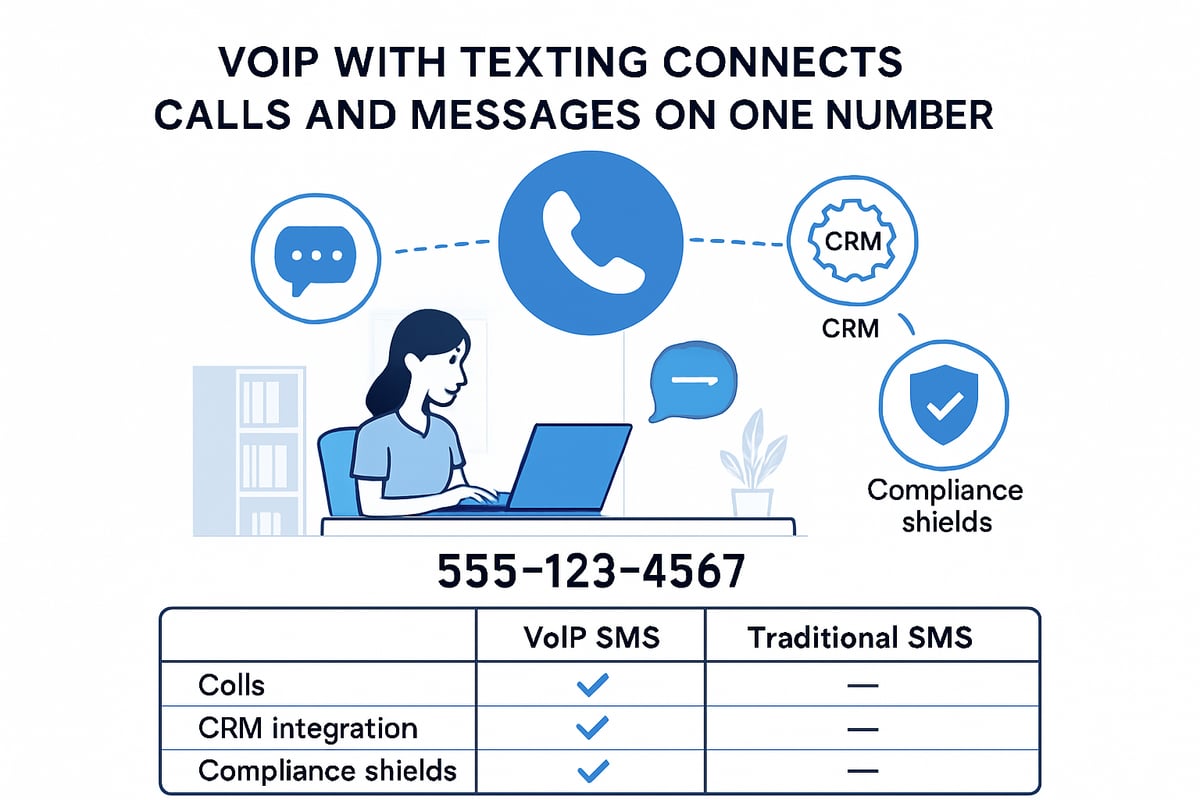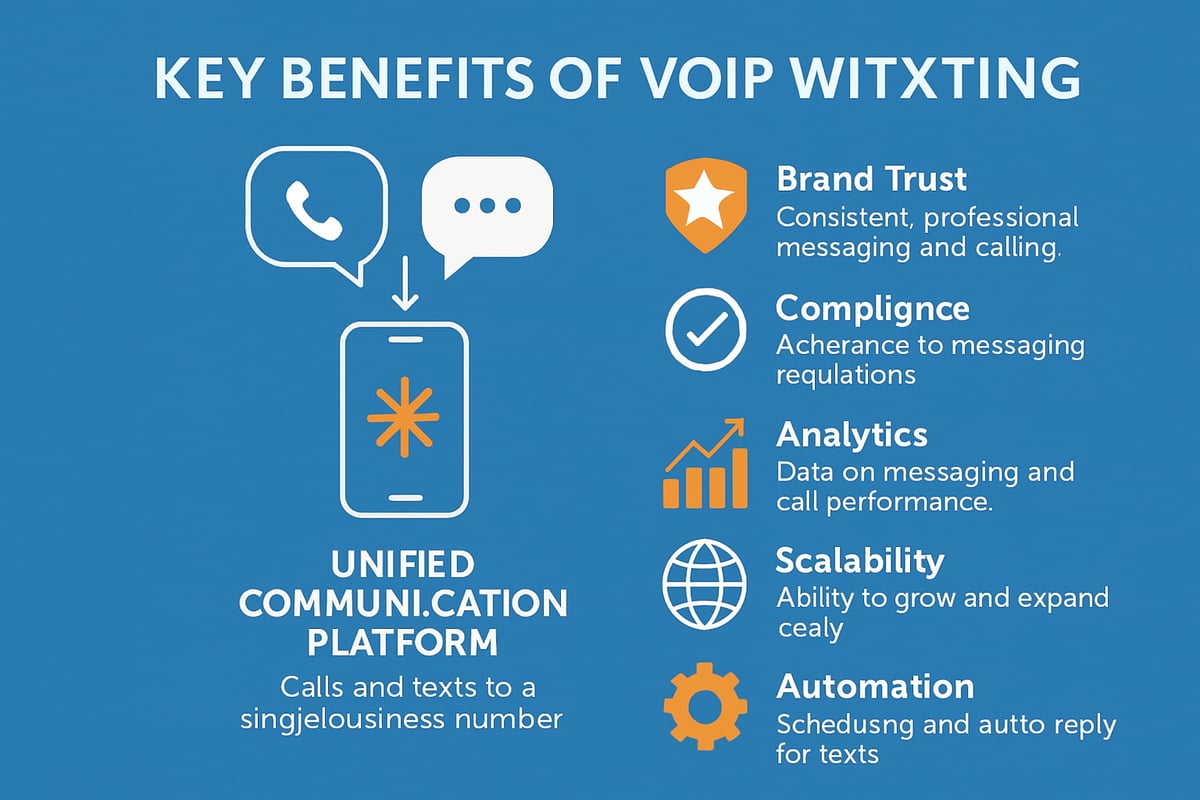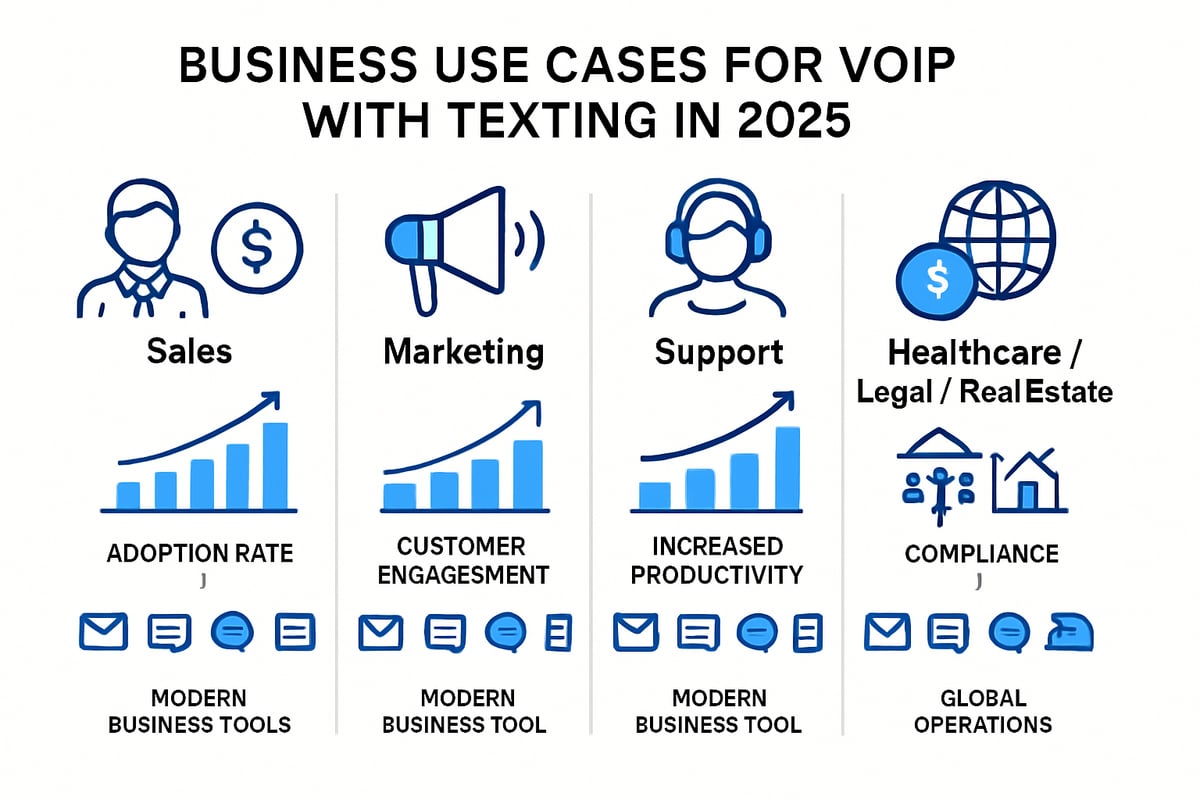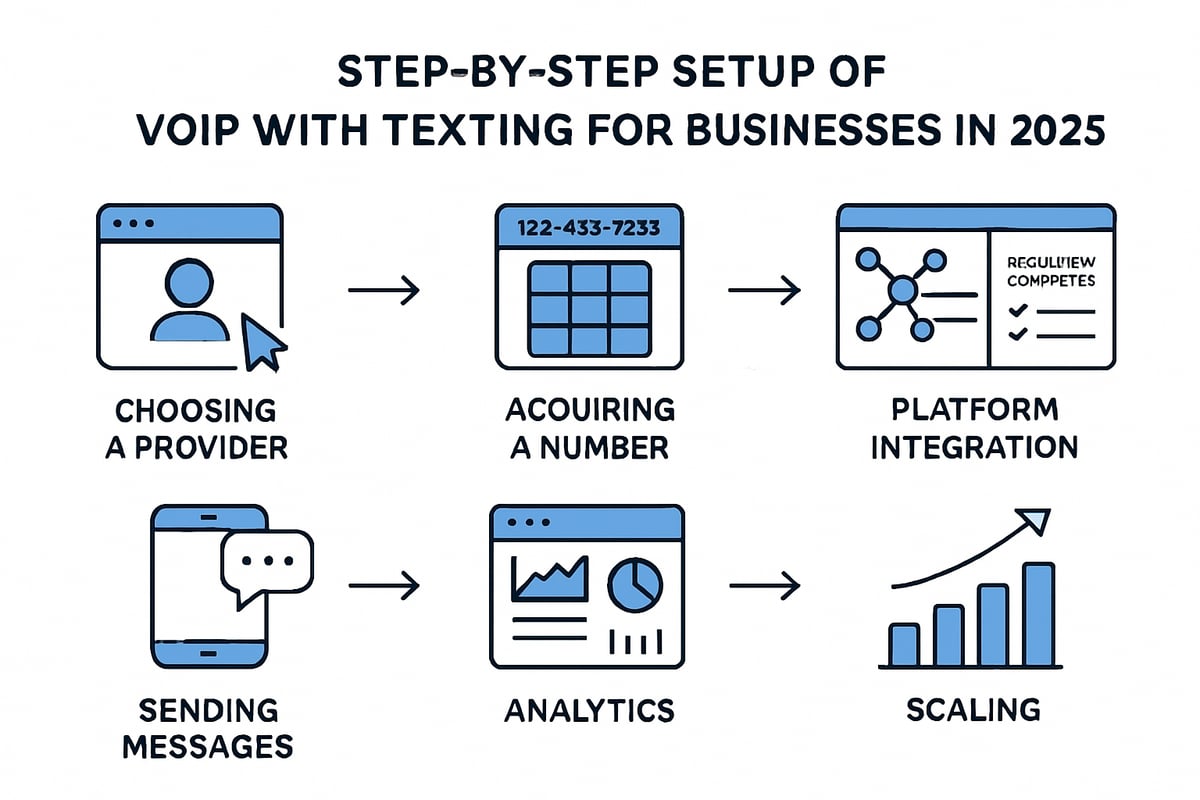VoIP With Texting Guide: How To Connect In 2025
Discover how voip with texting transforms business communications in 2025 with unified messaging, scalability, and actionable setup steps to future proof your strategy.
Redaction
09/10/2025, 12:30:00Business communications are undergoing a rapid transformation in 2025, as companies shift from traditional phone systems to voip with texting as the new standard. Unified, flexible communication is now essential for organizations looking to stay agile and competitive.
This guide will show you how voip with texting empowers businesses to connect with customers, scale operations, and streamline workflows in an increasingly digital world. Discover what voip with texting is, its key advantages, practical use cases, technical setup, essential features, and future trends.
Ready to future-proof your communications? Use this guide to take actionable steps and gain expert insights for seamless voip with texting setup and operation.
What Is VoIP With Texting?
Businesses in 2025 need agile communication solutions. VoIP with texting brings voice and messaging together under one roof, helping organizations connect smarter and faster. But what exactly does this technology mean, and how does it transform daily operations?

Definition and Core Concepts
VoIP with texting combines Voice over Internet Protocol (VoIP) technology - where voice calls travel through the internet - with the ability to send and receive SMS messages from the same virtual number. Unlike legacy phone systems, this unified approach lets teams handle calls and texts via laptops, smartphones, or desktops.
VoIP calling enables conversations over the web, while VoIP texting handles SMS through internet-connected platforms. Both services share the same number, supporting seamless transitions between voice and text. To activate texting, businesses request their VoIP provider to text-enable a number. This process may involve registering the business for compliance, especially under 2025 regulations that require verified business use for SMS.
A key distinction exists between VoIP SMS and traditional SMS. VoIP SMS uses the internet for message routing, while traditional SMS relies on cellular networks. This difference allows greater flexibility, such as sending messages from web dashboards or integrating with business tools.
| Feature | VoIP SMS | Traditional SMS |
|---|---|---|
| Network | Internet | Cellular |
| Device Flexibility | Any internet device | Mobile phones |
| Integration | CRM, helpdesk, APIs | Limited |
| Compliance (2025) | 10DLC, business IDs | Carrier rules |
Many service providers offer VoIP with SMS integration, helping organizations set up, register, and manage business texting. For example, a healthcare clinic can use one VoIP number for both appointment calls and text reminders, simplifying communication and compliance.
Key Differences from Traditional Phone Systems
Traditional phone systems rely on separate lines for calls and texts, often requiring multiple numbers or devices. VoIP with texting eliminates this complexity by allowing both functions on a single number, streamlining workflows and reducing confusion for staff and customers alike.
This approach also delivers significant cost savings, as businesses no longer need expensive physical infrastructure or multiple carrier plans. Instead, everything runs on existing internet connections, reducing overhead and maintenance requirements.
With VoIP with texting, organizations can integrate communication with modern platforms such as CRMs, helpdesks, and marketing suites. This integration centralizes customer data, enhances reporting, and enables automation for routine messages.
Consider a growing startup transitioning from analog phones to VoIP with texting. Instead of juggling landlines and company cell phones, the team manages all calls and texts from their computers. This shift not only boosts productivity but also provides flexibility for remote and hybrid workforces.
In summary, voip with texting offers a unified, scalable, and cost-effective solution that meets the demands of modern business communication.
Benefits of VoIP With Text Messaging
The rise of voip with texting is transforming how businesses connect, collaborate, and serve customers. By unifying calls and texts, organizations create a seamless experience that drives efficiency and trust. Let’s explore the core benefits that make voip with texting essential for modern business communication.

Unified Communication Platform
With voip with texting, teams manage calls and texts from a single dashboard. This unified approach cuts down on context-switching, making it easier for staff to stay focused and organized. Productivity rises when conversations are centralized rather than scattered across multiple apps.
Consider a sales team that uses voip with texting to follow up with leads. Representatives can call, text, and track interactions in one place, ensuring no opportunity slips through the cracks. Unified communication also simplifies training and onboarding for new staff.
- All-in-one interface for calls and messages
- Streamlined workflow for teams
- Reduced tool fatigue and confusion
Enhanced Customer Recognition and Trust
Customers value consistency. Voip with texting lets businesses send texts from the same number they use for voice calls, boosting brand recognition and reliability. This approach minimizes confusion and helps foster lasting relationships.
For example, a healthcare provider can call patients and send appointment reminders from a single recognizable number. Patients are more likely to respond promptly when they know who is reaching out.
- One number for voice and text
- Improved brand credibility
- Fewer missed connections
Simplified Compliance and 10DLC Management
Business texting in 2025 requires 10DLC registration and compliance. Voip with texting streamlines this process, allowing organizations to use one registered number for both calls and texts. This reduces administrative overhead and avoids duplicate efforts.
An insurance agency managing multiple offices benefits from voip with texting by maintaining compliance easily across all locations. The system ensures all regulatory requirements are met without the hassle of juggling several registrations.
- Single number for compliance
- Simplified 10DLC management
- Reduced risk of non-compliance
Centralized Data and Analytics
Voip with texting brings all customer data and communication logs into a single platform. This centralization enables better reporting, faster response times, and deeper insights into customer behavior.
A real estate firm, for instance, can track every client interaction - calls, texts, and follow-ups - in one place. This unified view not only aids compliance but also helps improve client service.
- Comprehensive communication logs
- Actionable analytics dashboards
- Easy data retrieval for audits
Scalability and Flexibility
As organizations expand, voip with texting offers unmatched scalability. It is simple to add new lines, users, or locations as business needs change. Whether supporting remote teams or launching new campaigns, voip with texting adapts quickly.
A restaurant chain can use voip with texting to send bulk promotions or handle reservations across multiple sites. The platform grows with the business, ensuring consistent communication everywhere.
- Effortless user and line additions
- Support for remote and hybrid work
- Bulk or personalized messaging options
Automation and Integration
Automation is a major advantage of voip with texting. Businesses can deploy autoresponders, templates, and scheduled messages to save time on routine tasks. Integration with CRM and marketing platforms further streamlines workflows.
For example, a car dealership can automatically send appointment reminders or follow-ups, freeing staff to focus on high-value interactions. This level of automation ensures no engagement is missed.
- Pre-built message templates
- Seamless CRM and tool integrations
- Scheduled and triggered communications
Accessibility and Mobility
Voip with texting empowers teams to call and text from anywhere with internet access. This flexibility is crucial for mobile and distributed workforces, enabling real-time collaboration regardless of location.
A construction company, for example, can coordinate crews across multiple sites using voip with texting. Staff stay connected on the go, making field operations smoother and more efficient.
- Mobile and remote access
- Real-time updates for teams
- Consistent communication in the field
Use Cases for VoIP With Texting in 2025
In 2025, voip with texting is transforming how businesses connect, engage, and operate across industries. The adoption of unified communication platforms is accelerating, enabling organizations to streamline workflows and improve responsiveness. With voip with texting, companies can unlock a wide range of practical applications that drive growth and efficiency.

Sales and Lead Generation
Voip with texting is a powerful tool for sales teams seeking to engage prospects and accelerate conversions. Instant messaging allows teams to send personalized quotes, appointment confirmations, and follow-up reminders, all from a single business number.
- Nurture leads with timely SMS updates
- Automate demo reminders to boost attendance
- Track engagement for better pipeline visibility
According to VoIP adoption statistics 2025, businesses leveraging modern communication see higher lead response rates and improved sales outcomes. Voip with texting ensures sales professionals remain accessible and responsive.
Marketing and Promotions
Marketing teams use voip with texting to deliver targeted campaigns and promotions directly to customers’ mobile devices. SMS messages have high open rates, making them ideal for time-sensitive offers and event announcements.
- Segment audiences for personalized outreach
- Launch product campaigns with instant notifications
- Measure campaign effectiveness with analytics
By integrating voip with texting into marketing platforms, companies can monitor real-time results and refine strategies for better ROI. This approach keeps brands top of mind and drives measurable engagement.
Customer Support and Service
Voip with texting enhances customer service by offering fast, convenient communication channels. Support agents can address inquiries, confirm appointments, and provide status updates without requiring a phone call.
- Use templates for common questions
- Escalate from text to call when needed
- Maintain unified records for compliance
Healthcare providers, for example, use voip with texting to send appointment reminders from the same number patients call, reducing confusion and missed connections. This unified approach builds trust and streamlines support.
Team Collaboration and Internal Communication
Internal teams benefit from voip with texting by coordinating projects and sharing information quickly. Group texts and broadcast messages enable real-time updates across departments or remote locations.
- Share schedules and alerts instantly
- Coordinate field teams or shift changes
- Foster collaboration in hybrid work environments
Event management companies, for instance, use voip with texting to update staff during live events, ensuring everyone stays informed and aligned. This flexibility supports agile communication in dynamic settings.
Industry-Specific Applications
Various industries leverage voip with texting for specialized needs. In healthcare, SMS reminders and prescription alerts keep patients on track. Real estate agents confirm property viewings, while law offices send confidential case updates securely.
- Secure client communication for legal and financial services
- Automated reminders for healthcare appointments
- Real-time updates for real estate transactions
Voip with texting adapts to regulatory requirements, ensuring sensitive information is handled appropriately and securely across sectors.
Global and Remote Operations
For organizations with international or distributed teams, voip with texting provides seamless global coverage and local presence. Businesses can use local numbers to comply with regional regulations and foster trust with local customers.
- Support remote teams with unified communication
- Manage operations across multiple countries
- Enable multilingual messaging for diverse audiences
Multinational enterprises rely on voip with texting to maintain consistent communication standards worldwide, regardless of location or device.
How VoIP With Texting Works: Step-by-Step Setup for 2025
Setting up voip with texting in 2025 is straightforward if you follow a structured process. The right approach ensures your business communication remains scalable, compliant, and efficient. Let’s walk through the essential steps to get your voip with texting solution live and optimized for your team.

Step 1: Choose a VoIP Provider That Supports Texting
The first step in implementing voip with texting is to select a provider that offers robust texting capabilities alongside voice services. Start by assessing your business requirements: Do you need local, toll-free, or international numbers? How important are compliance, analytics, and integrations for your workflow?
Create a shortlist of providers that deliver reliable voip with texting, strong security, and customer support. Compare features such as 10DLC compliance, number portability, API access, and reporting tools.
| Criteria | Must-Have Features | Questions to Ask |
|---|---|---|
| Coverage | Local/global numbers | Which countries are supported? |
| Compliance | 10DLC, GDPR, HIPAA | How is compliance handled? |
| Integrations | CRM, helpdesk, marketing tools | What integrations are native? |
| Analytics | Real-time reporting | What data can I access? |
For a comprehensive overview of the onboarding process, read Get started with VoIP to ensure you are prepared for each phase.
Step 2: Acquire and Text-Enable Your VoIP Number
Once you have chosen your provider, the next step in voip with texting deployment is obtaining a voip number and enabling it for SMS. Most providers allow you to select new numbers or port existing ones. After selection, request SMS/text enablement for the number.
Understand 10DLC (10-digit long code) registration requirements, as all business texting in 2025 must comply with carrier regulations. Your provider will guide you through submitting use case details and registering your brand. This minimizes message filtering and ensures reliable delivery.
Example Timeline:
- Day 1: Request number and submit 10DLC details
- Day 2-3: Provider reviews and registers number
- Day 4: Number is live for both calls and texts
By consolidating calls and texts on one number, your voip with texting setup reduces confusion for customers and simplifies compliance.
Step 3: Set Up Your Platform and Integrations
With your number active, configure your voip with texting platform to suit your business structure. Create user accounts, assign permissions, and connect devices (softphones, mobile apps, desk phones).
Integrate the platform with your CRM, helpdesk, or marketing systems to centralize records and automate workflows. Most leading solutions offer prebuilt connectors or API access for custom integrations.
Here’s a sample integration using a CRM API:
import requests
api_url = "https://provider.com/api/send_sms"
data = {
"number": "+1234567890",
"message": "Welcome to our service! Reply for support.",
"crm_id": "customer123"
}
response = requests.post(api_url, json=data)
print(response.status_code)
A well-integrated voip with texting system accelerates onboarding and empowers teams to manage communications from a single dashboard.
Step 4: Send and Receive Text Messages
Now, your team can begin using voip with texting for day-to-day operations. Start by sending individual or group texts directly from your unified interface. Set up message templates for common scenarios, such as appointment reminders or order confirmations.
Leverage features like autoresponders for after-hours replies and schedule messages for future delivery. Monitor delivery and read receipts to ensure messages reach their recipients.
Best Practices:
- Use clear, concise language in texts
- Personalize messages with customer data
- Schedule follow-ups to improve response rates
A streamlined voip with texting workflow supports fast, reliable communication with customers and colleagues.
Step 5: Monitor, Analyze, and Optimize
Effective voip with texting relies on continuous monitoring and optimization. Use built-in analytics to track message delivery rates, response times, and campaign effectiveness.
Set up dashboards to visualize trends, identify bottlenecks, and compare performance across teams or locations. Use these insights to refine message templates, adjust scheduling, and optimize workflows.
Compliance Checklist:
- Review opt-in and consent records
- Monitor for spam or delivery failures
- Update privacy and security settings regularly
Regular analysis helps your business stay compliant and responsive as regulations and customer expectations evolve.
Step 6: Scale and Maintain Your VoIP Texting System
As your business grows, your voip with texting solution should scale effortlessly. Add new numbers, users, or office locations through your provider’s admin panel. Support international expansion by acquiring local numbers for each region.
Troubleshoot issues such as delivery failures or spam filters using provider tools. Plan for regular updates and feature enhancements to keep your system secure and efficient.
Tips for Scaling:
- Document processes for onboarding new users
- Schedule routine system health checks
- Stay informed about regulatory changes
A future-ready voip with texting platform adapts to changing business needs, enabling continuous growth and innovation.
Key Features to Look for in VoIP With Texting Platforms
Choosing the right voip with texting platform is crucial for modern businesses aiming to future-proof their communications. As organizations demand more reliability, flexibility, and integration, evaluating the following features will help ensure your solution meets both current and evolving needs.
Reliability and Uptime
Reliability is non-negotiable for voip with texting platforms. Look for providers that guarantee 99.99% uptime, ensuring your business stays connected during critical moments. Automatic provider failover and resilient infrastructure protect communications from unexpected outages.
For example, if your network faces an issue, automatic rerouting keeps your calls and texts flowing seamlessly. This level of reliability is essential for industries like healthcare and finance where downtime is simply not an option.
Global Coverage and Local Numbers
Global reach is another key feature of voip with texting solutions. The ability to access numbers in over 190 countries enables businesses to establish a local presence anywhere. Local numbers foster familiarity and trust with regional customers, improving engagement and response rates.
Consider a multinational company that needs support lines in various countries. With voip with texting, they can quickly activate local numbers without investing in physical infrastructure, keeping communications agile and cost-effective.
Compliance and Security
Compliance and robust security are critical in today's regulatory landscape. Top voip with texting platforms support 10DLC, GDPR, HIPAA, and other regional regulations. End-to-end encryption and secure data handling protect sensitive information from breaches.
For a deeper dive into industry risks, review VoIP security challenges to understand why strong safeguards matter. For example, healthcare providers must ensure patient data is always encrypted and compliant with legal requirements.
Real-Time Analytics and Reporting
Advanced analytics are indispensable for measuring communication performance. Voip with texting platforms should provide dashboards for delivery tracking, open rates, and cost analysis. These insights empower businesses to optimize campaigns and workflows.
Imagine a retailer adjusting its promotional SMS strategy based on real-time data, boosting engagement while reducing costs. Unified analytics also help teams respond faster and improve customer satisfaction.
Developer Tools and Integrations
Seamless integration with business systems sets leading voip with texting platforms apart. Comprehensive API documentation and SDKs make it easy to connect with popular tools like CRMs, marketing automation, and helpdesks.
This flexibility allows a fintech app to enable SMS verification or a sales team to automate follow-ups. For an overview of top platforms supporting these features, see Best VoIP solutions for business.
Automation and Personalization
Automation tools are vital for scaling communications. Look for features like bulk messaging, segmentation, templates, and scheduling. Personalization capabilities let businesses tailor messages to individual customers, increasing relevance and impact.
For instance, an insurance agency can automatically send policy renewal reminders, while a car dealership schedules appointment follow-ups using tailored templates. These tools streamline operations and enhance the customer experience.
Support and Customer Service
Reliable support is the backbone of any voip with texting platform. Prioritize providers offering live chat, email, and dedicated account managers. Fast response times and expert troubleshooting minimize downtime and keep operations running smoothly.
If an enterprise encounters technical issues, responsive support ensures quick resolution and business continuity. This level of service is especially important for mission-critical environments.
| Feature | Benefit | Example |
|---|---|---|
| Reliability/Uptime | Business continuity | Automatic failover during outages |
| Global Coverage | Local presence in multiple countries | Regional support lines for multinational |
| Compliance/Security | Data protection, regulatory adherence | HIPAA-compliant patient communication |
| Analytics | Campaign optimization, performance insights | Real-time SMS delivery tracking |
| Integrations | Streamlined workflows, automation | CRM integration for lead follow-up |
| Automation | Scalable, personalized communication | Scheduled bulk messaging |
| Support | Rapid issue resolution, peace of mind | Dedicated account manager for enterprises |
Future Trends: VoIP With Texting in 2025 and Beyond
The pace of change in business communications will only accelerate in 2025. As organizations seek to future-proof their operations, voip with texting will continue to evolve, integrating advanced technologies and adapting to new business needs. Let us explore the trends shaping the next era of unified messaging.
AI and Automation in VoIP Messaging
Artificial intelligence is redefining how businesses interact with customers. In 2025, voip with texting platforms will leverage AI-powered chatbots, natural language processing, and smart autoresponders to deliver instant, accurate responses. Predictive analytics will anticipate customer needs, enabling proactive outreach and faster resolution.
Many providers are integrating real-time transcription, sentiment analysis, and automated workflow triggers. These capabilities reduce manual workload and elevate the customer experience. For a deeper look at how AI is transforming communications, see the AI integration in VoIP overview.
Rich Communication Services (RCS) and Multimedia Messaging
The transition from SMS to RCS will bring richer, more interactive messaging to voip with texting. Businesses can send images, videos, buttons, and branded content directly to customers' devices. This enhances engagement and opens new possibilities for marketing and support.
RCS also supports read receipts and typing indicators, creating a chat-like environment. Imagine an e-commerce store sending product images, order tracking links, or clickable promotions, all within a secure, branded message thread.
Integration with Omnichannel Platforms
Unifying communication channels is essential for modern organizations. In 2025, voip with texting will seamlessly integrate with email, chat, and social platforms, allowing teams to manage all interactions from a single dashboard. This centralization improves efficiency and ensures consistent customer journeys.
Businesses can map touchpoints, automate follow-ups, and escalate conversations from text to call or other channels as needed. The result is a streamlined workflow and improved customer satisfaction.
Advanced Security and Compliance Solutions
Security remains a top priority as messaging becomes more sophisticated. Voip with texting platforms will adopt advanced encryption, biometric authentication, and automated compliance monitoring. These features are critical for industries handling sensitive data, such as finance and healthcare.
Compliance with regulations like GDPR, HIPAA, and regional privacy laws will be built into platforms. Automated alerts and audits help organizations stay ahead of evolving requirements and protect customer trust.
Expansion of Global Reach and Localization
As the voip with texting market grows, businesses will benefit from broader global coverage and localization features. Providers will offer more local numbers, multi-language support, and regional compliance tools. This enables organizations to connect with customers worldwide while respecting local preferences and regulations.
According to VoIP market growth trends, the demand for flexible, cross-border communication is driving rapid adoption and innovation in this space.
Evolving Regulatory Landscape
Regulatory frameworks for business messaging are continuously changing. In 2025, new rules for consent, spam prevention, and 10DLC registration will shape how organizations deploy voip with texting. Staying compliant will require proactive monitoring and quick adaptation.
Platforms will provide built-in compliance checks, up-to-date templates, and guidance on best practices. This reduces legal risk and ensures smooth, uninterrupted communication.
Preparing for the Next Wave of Communication Innovation
The future holds even more potential for voip with texting. Integration with IoT devices, AR/VR applications, and voice-to-text AI will unlock new ways to connect and collaborate. Businesses that stay agile and embrace emerging technologies will be well-positioned to lead in an evolving landscape.
By investing in scalable, secure, and intelligent messaging solutions, organizations can ensure their communication strategies remain effective and future-ready.As you’ve seen throughout this guide, VoIP with texting is transforming the way businesses connect, scale, and deliver outstanding service in 2025. By unifying calls and texts, you can streamline your workflows, boost team productivity, and future proof your communications - no matter where your clients or teams are. If you’re ready to experience enterprise grade reliability, rapid SMS delivery, and seamless integration with tools you already use, there’s no better time to take the next step. Let’s make your communications smarter and more efficient together - Start now!